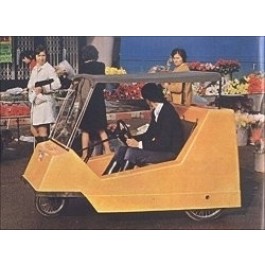Browse By
|
Vitrex RiboudDescriptionThe Riboud was first built in France 1974 though a prototype had been created a few years earlier. The vehicle was based on an idea by Jacques Riboud who at the time was the chairman for a society that built houses A lot of his customers were living in Paris and due to overcrowded roads suffered intense traffic problems which were further increased with strikes by public transport workers. Riboud thought that a small vehicle would be excellent for his customers as its tiny size would mean increased manoeuvrability through the overcrowded streets. As his facilities were able to take care of the body and the motor Riboud set to work on the project and gave everything to his designer and engineer to build a prototype. When the car was completed he called it " le Hanneton ", ( the " Bug " ), Riboud however was disappointed as the vehicle was not what he had hoped but an interesting opportunity came at the start of the 70's when a society called " Marland ", ( which was very well known by its famous buggies) was contacted by Riboud to create another project that was based on the Hanneton. This new project was a success and Riboud, was very pleased with it as this was the type of vehicle he wanted from the start ! Many other prototypes were built and presented to the car press, before the car was finally considered as a micro car ( voiturette sans permis, literally " without driving license car " ). The car, powered by a 47cc Sachs engine, was finally called the " Riboud ".The homologation papers were given by the " service des mines " ( where all cars had to go to be homologated ) at the end of June 1974, with a " type mine " called " M.R.1. " ( Marland-Riboud 1st version ). Marland decided to build these cars in its factories of the Eure ( French department n° 27 ). Some of cars were direct sales whilst some were delivered to Riboud’s houses. Detailed Information
|





